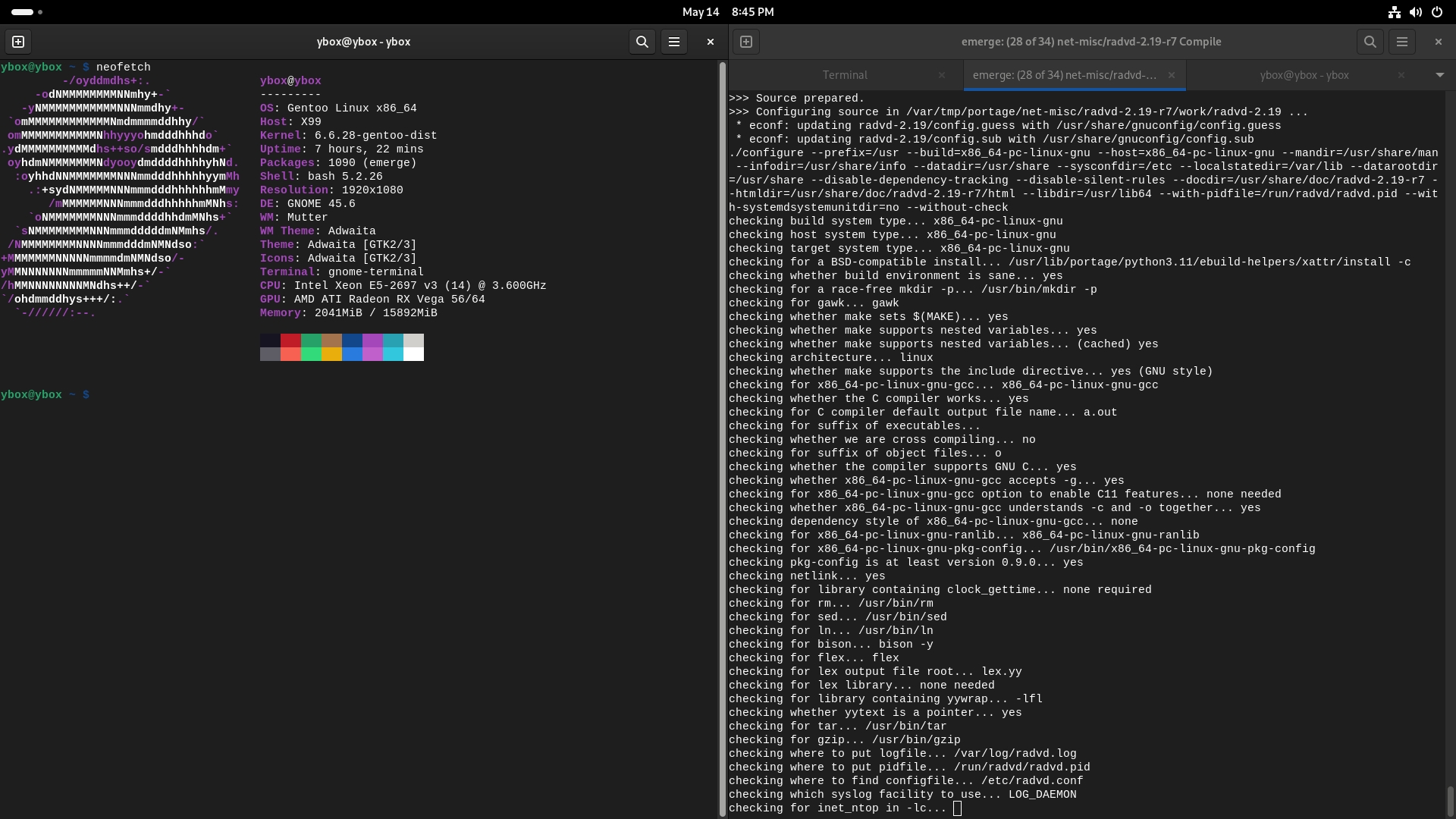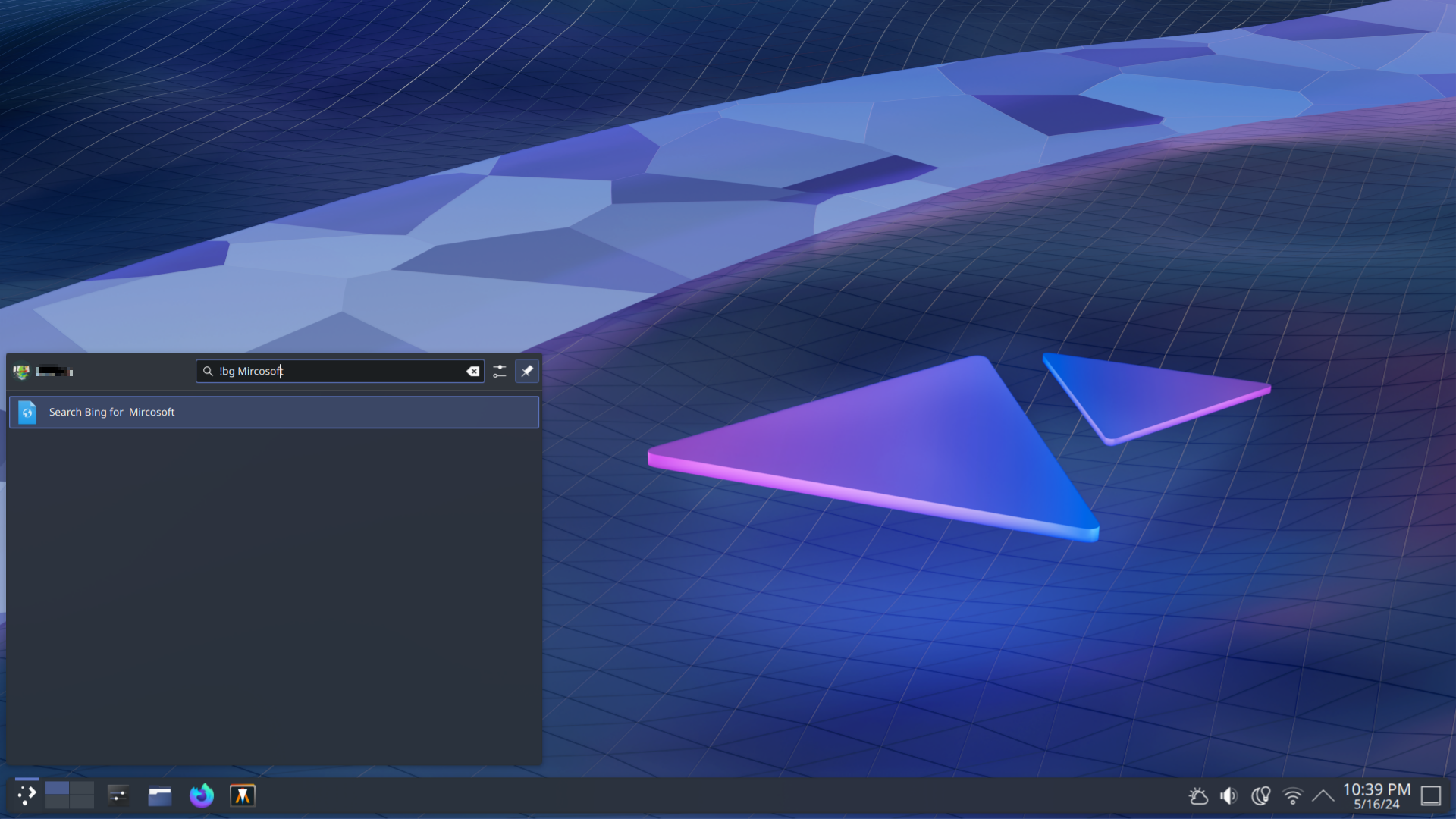Terminal > Windows Registry.
The other day I was trying to disable Ubuntu Pro stuff and the way to do it reminded me of Windows. Once I get my media backed up I’m switching to another distro, just not sure what one yet.
You seem to me like a fedora or mint person 😁 like in the sense that I think you’d like them
I threw Ubuntu 24.04 in a VM it’s been a few years since I’ve used it.
I was unpleasantly surprised.
Wait, this is actually a good tip lol
“Holy Hannah!” That’s great

“Montana Banana!” also an acceptable exclamation
Pay no attention to gconf, dconf, GSettings, or whatever else there is.
Or messing with text configuration files in various different formats
I’d take plain text files over the registry any day of time.
Ha nerds Imagine using the terminal!
Wait. Wait. Nevermind

(Me rn)
You’re not using a command line web browser? I wouldn’t either.
Piece of advice: add -qv to your emerge command to let Portage show the things you need to know but stay quiet otherwise. Way less gets shown on the terminal window and on some systems it might slightly speed up the process.
Thanks for the info! On a seprate note gentoo package managment is so magical! You get to choose whats built and all the amazing features portage has like distcc and ccache. Its so much fun playing with this kinda stuff!
I even have to tell stupid windows to interpret the bios clock as UTC.
Or set the clock in Linux to local time
Normal people (idiots) would rather spend 4 years of their overall life “hacking” with Windows to avoid 30 minutes learning to use a forward slash.
deleted by creator
I once spent several hours at work trying to mount a USB drive to red hat. I’ll keep fighting windows for now.
deleted by creator
On work machines, it may also be on purpose (IT department having restricted the use of USB storage).
Yeah. If that’s not one of the first things IT did when they got hired, then you need a new IT. You seriously can’t trust anyone to not plug a random USB into volatile infostructure.
Also, they could do it to prevent theft of their proprietary code and other things that you’d probably need to sign a NDA to even see in the first place.
I don’t think so; there was a procedure for it and we had root access. It just didn’t work according to the procedure, nor any of the ones I found online. If I remember correctly, it said to mount sda1 and that didn’t work. Another different machine worked with sdb0 or 1. Ended up having to plug a laptop in with a network cable and ftp the files.
/dev/sda1 might have been your computers hard disk, with “sda1” in the instructions being an example.
Meanwhile the entire Internet :
https://example.com/Laura/EpsomLaura Epsom? Is that Lorem Ipsum for the barbaric tribes of Britannia?
Specifically these Britons. https://youtu.be/F33HokcX8M0?si=EfpM3X0PxsnmkQnS
Here is an alternative Piped link(s):
https://piped.video/F33HokcX8M0?si=EfpM3X0PxsnmkQnS
Piped is a privacy-respecting open-source alternative frontend to YouTube.
I’m open-source; check me out at GitHub.
Tfw windows uses forward slashes too. Now let’s talk about how *nix is case sensitive because laziness.
But all fall short of God’s glory that is Temple OS.
I won’t have the perfect OS until I’ve rewritten Temple OS from scratch as Hannah Montana’s Temple, The OS
You sound like an (idiot); you as an individual are not defined by your OS of preference of all things, and by all means, you are one of the normals.
yeah, and most people dont even know linux exists
thats like calling a kid dumb for not understanding how multiplication works when they havent yet learned it in school
(Idiots)… Way to roast normal people. Don’t know if they will ever recover. The best bit was putting it in brackets.
You are normal people.
You are normal people.
For a fact, i’m not normal.
Ready, normal people?

I’m ready, Trekkie Monster!
I’ve spent ways less time editing the windows registry than I’ve spent trying to fix all the dual monitor bugs with linux.
Windows issues/changes are a 30 second google search away, linux issues often enough require a 1 hour deep dive into multiple forums.
I do technical support (mainly Windows but some Linux) and fully agree; most people just want to project for one reason or another. My main concern is privacy and bloat, but those are easy enough to address on either platform.
Wayland pretty much solves every single dual monitor issue. Only problem now is getting complete Nvidia support and patching out edge cases. I dual monitor all the time, and not just normal dual monitor either, the monitor count increases or decreases on a whim and not a single screen in use are the same. They all have different refreshing rates, resolutions, orientations, vrr & hdr support, color ranges, etc. everything works as expected.
Last time I checked (during the installation of Fedora 39), HDR support was nearly non-existent in Linux, with the only options being some hacky experimental support for gaming via Gamescope. Has that changed in the last 6 months? It’s the only thing holding me back from jumping to Linux these days.
KDE Plasma 6 has experimental HDR support. The HDR Wayland protocol isn’t finished just yet. Here’s a good source.
It… Depends… Also, you picked the wrong platform to argue against Linux on 😅
The fact that you have to say it depends and wait for clarification of which exact flavor of Linux version and problem it is is just chef’s kiss
Ah yes, no counter arguments here, only patting on the back while everyone takes turns looking down on a different group of people.
Have you googled Windows issues? Every problem apparently is fixed by running chkdsk or download a “driver updater”. And it wasn’t exactly good in the past either.
If you don’t know what to search, how to word it, or where to look instead of clicking the first link with “[SOLUTION]” then maybe you shouldn’t be troubleshooting…
Oh come off it. Obviosuly you don’t click those the problem is the Microsoft support articles are outdated/missing and their own forums aren’t much better.
The chaff you have to cut through for Microsoft products is on another level.
I was actually just looking for this the other day. I’ll let you know if it actually works.
Reminds me of when I tried to install Firefox on Ubuntu and it said it couldn’t open the download as there was nothing associated with it. Ended up with another copy without an icon but it worked. Then I moved to Fedora which seemed to work as intended. Couldn’t run Mint on this laptop as it boots to a black screen - presumably the wrong GPU. Daily Driver is Windows 10 by necessity.
I get the impression “opening a file” is treated as a different action in Linux from “executing a file”. They don’t want the user request of “Oh, I guess I’ll look at this image” to accidentally result in a system takeover - so any “run this file” actions are more manual.
I think it’s becasue I downloaded a deb file or something that Canonical had decided was not allowed any more. Recent conroversy
One thing Linux needs to do is change the perception of how hard everything is compared to Windows. Some things are extremely less difficult on Linux.
Both OS are hard if you don’t know how to use them.
Both OS are easy if you know how to use them.
Linux’s problem is fragmentation. There’s not a single OS that many people are familiar with like Windows. Instead there’s hundreds of different distros that all function in a variety of different ways. Even if a person learns to do something on Mint or Ubuntu, they will be completely lost trying to do the same thing on Fedora or Arch.
I’d argue that there’s like 4 ways that 90% of distros work like and even they are extremely similar to each other. You got Fedora, Debian, Arch, and whatever Gentoo users do when they are in the dark in the basement. The rest are niche and weird stuff that not even Linux hardcore fans know all about. Similarly there’s only two desktop things that matter, GTK or QT. Everything else is us nerds nick-picking.
Ok, there’s also nixOS and the new wave of atomic monolithic containerized whatever distros, but they are like, super new and the resulting system is indistinguishable for the end used from the other 4 main.
hundreds of different distros
And out of those “hundreds” only a handful of them are actually popular and progressing innovation…
As someone who’s distro hopped across a wide verity of distros, the fundamentals are more less the same across all of them. Just go with a popular distro with good documentation and you’ll be fine. If you’ve learned enough from mint to feel comfortable tackling Arch Linux, then the documention (e.g. ArchWiki) will be your strongest asset.
Good documentation is great to have. Here’s the thing though. If you need documentation to use an OS… That just proves that it really is harder for people to use.
Mint and Windows both share the ability to pick it up and use it for the majority of what most people do. Arch is like the textbook example of having to learn a bunch in order to use Linux.
I think Arch is meant for people who want to learn the software - so that you can also choose, control, customize, diagnose, and fix the software!
That said, archwiki is still a great resource on other distros for when something does go wrong, or when it’s not obvious how to do something, particularly when messing with experimental or server stuff.
The Arch wiki is one of the main reasons I use Arch/Arch based Distros. Its so insanely good and after you learned some of the basic stuff and what certain terms mean its a very good resource for doing stuff.
You forgot the entire point of Arch Linux, it was never meant for newbies, bud.
Arch is the easy way, when you compare it to Debian Sid.
I have used Windows since I was a child and I still need “documentation” to do routine things, because they hide stuff 8 levels deep inside an obscure settings window that requires an arcane ritual to access.
Definitely this. I have been eyeballing Linux for years, always intimidated by the CLI and the notion that everything you try to do on Linux requires user research and work first.
Now I finally made the switch a couple days ago, and while it took a bit of tinkering and googling here and there I am amazed how simple, even way simpler than on windows, the experience for a an average user is, particularly with the very beginner friendly distro I went with (bazzite/gnome).
It just works right out the box for 90% of whatever I want to do, configuring it is simply flipping some switches in the software and extension apps. Feels more like setting up a new smartphone than a PC. I didn’t even have to mess with the CLI all that much, perhaps half a dozen times so far, and each time i followed specific steps in a guide or tutorial, or tried out some basic things like file search.
It is good to send new users to something like Gnome they can branch out. I think Cosmic will be a great fit as well. Outside of updates, you don’t have to do too much in the CLI really. But long as you learn some of the basics how to get around and maybe make an alias. I think that will get you by just fine on Linux. I do think people should get users to try less Windows like experiences on Linux. Because a Windows like UI will just make them miss Windows.
I do think people should get users to try less Windows like experiences on Linux. Because a Windows like UI will just make them miss Windows.
That is actually the exact reason I went with gnome instead of KDE myself; I find it much easier to learn a new system than to adjust habits that have formed for years. I will probably eventually switch to KDE when i feel fully comfortable, because it is supposedly slightly better in performance and far more customizable.
I’ve been using KDE Plasma for 5 years now and I’ve never missed Windows UI.
I always show people single click printer setups.
Linux (and sometimes Android) is the only platform printers actually work reliably.
You have to click? I turn on my networked printer and every Linux machine on my network sets it up whether I wanted them to or not.
Which printer?
Wtf?
You’d shatter the world and identities of everyone currently using Linux then. If it were more accessible, ya’ll couldn’t be in here jerking eachother off and sniffing your own farts.
That’s like 80% of the appeal of Linux, I am totally convinced.
I am convinced you breathe that gas that broke the ozone layer.
Imagine being this unironically toxic… in a meme community.
Yeah, sure, we like to promote it because it’s… harder??
Problem is is that is that too many people insist on doing things the Windows way and they get frustrated because of it. For example, instead of going to the software center, they choose to download their programs from a website, even though that’s not how you’re supposed to do it most of the time. They’ll also spend hours trying to get Windows only programs to run, when there are alternatives available that work just as well.
That’s absolutely true. I made the same mistakes and I got absolutely mad.
I still don’t fully know how to install rpm files lmao, that’s how I learned about Apt back on linux mint, don’t remember what I was trying to install as it was like 15 years ago. Deb files were nice because they did work like a windows user would expect.
I don’t even know what rpm files are xD. I personally havent figured out how to make use of a tar.gz file.
A tar file is similar to a ZIP file. The easiest way to uncompress them is by using your file manager and right clicking.
I know, but since Programms often ship as tar.gz I still have no fucking clue on how to finally install a Programm from it.
Let’s use Tor Browser as an example since that’s one of the programs that typically gets installed with a tarball. Once you’ve downloaded and extracted the tarball, you’ll want to navigate to the extracted files. You can do this in the terminal using CD commands, but I think it’s easier and a little more intuitive to just use your file manager and navigate to the folder that way. Once you’re in the correct folder, you’ll want to right click on an empty space and select “open and terminal.” Now you’ll have a terminal open and it will already be in the correct directory. From here you’ll want to run the “start-tor-browser.desktop” script. To do this, simply type ./start-tor-browser.desktop and you’ll be able to follow along from there.
Running programs from a Tar image typically involves running a script. You just have to change the name of the script to match whatever they have in the directory. Auto complete is your friend here. You don’t have to actually type the entire name of the script, you only need to type the first few letters and then hit tab.
Using Linux isn’t hard. Switching to Linux is hard.
Voidtools “Everything” is how we mimic a fraction of your power thank-you-very-much.
There are literally dozens of us Everything users.
please elaborate what this is about?
The everything search engine is flexible and fully indexed file search engine but you can use to find any file anywhere on your network or local storage, instantly, and only a little bit slower than instantly on a very slow old machine.
sounds impressive
It is a file search engine that replaces your regular earth in Windows.
I agree that this is bullshit and Linux is better. But as someone with a Windows work computer, this was a huge help.
Why are we even comparing the terminal with registry? What is registry mimicking from Linux?
/etc
In this case, I’d say it’s less about how the registry works, and more about how deliberately obnoxious Microsoft makes the experience for the sake of their agenda.
Sure if you have to deal with the registry at all, it’s “hard” but that’s casting stones from a glass house as dconf can be just as hard, and then you have the odd occasion where someone suggests dbus-send, which certainly doesn’t have room to mock registry handling as hard. The point is that most people never have to touch dconf/dbus directly to do what they want, and in Microsoft some things are deliberately obscure due to user hostile intentions.
Deliberately obnoxious that can be disabled by a single registry edit?
A single registry edit to a key that doesn’t exist because they wanted to obscure that it was possible.
For the “don’t care” computer user? absolutely. Given that the key doesn’t exist at all by default, means it’s not discoverable even for someone that might think to randomly peruse the registry hierarchy. Even if you know it, it’s a typically tedious registry path. Based on Microsoft’s track record, the fact you know the registry key today doesn’t mean that key won’t change behaviors or move somewhere else randomly, or start having to be paired with some other registry key.
Contrast with Plasma, where the same capability is possible, and I just right clicked the button to check out settings and could easily figure out without help or internet search how to enable/disable internet results in the search. Further when I enabled it, the non-internet search stayed blazing fast. Then disabled it again because, well, why would I want that. I did however add browser tab search since I bothered to look because that is handy, just removed history and web search.
Season 2 of Invincible really hasn’t been great. Was it made during the writer’s strike?
You think you’re powerful? now try to enable bing results in Linux search
That’s literally the easiest thing.

Of course KDE supports that…


























